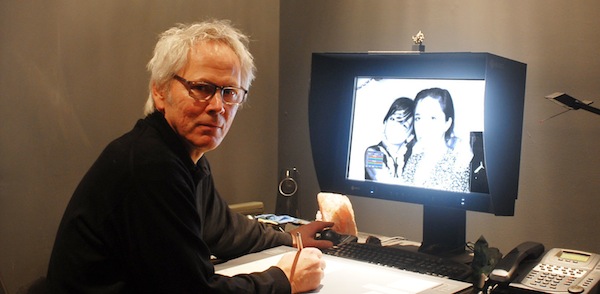
In conversation with Brad Palm, master retoucher for Speaking of Home
By Meena Mangalvedhekar, Speaking of Home
Speaking of Home received a $25,000 grant to create a public art project focused on illuminating the lives of Minnesota’s diverse communities while transforming the St. Paul skyway system. Today production coordinator Meena Mangalvedhekar checks in with Brad Palm, Speaking of Home’s “super power” and photographic retoucher…
SOH: What led you to become a photographic retoucher and what continues to inspire you? Brad Palm: In the late 1970s, it was sort of like a rubber mallet hit my head, unexpectedly. I was first hired as a staff artist at a reputable company where I worked in the darkroom as well as cutting matt for framing. The company had a small retouching studio in the basement. It was specially equipped with genuine Kodak dyes and some exotic chemicals for the purposes of lightening up individual dye layers in E-6 film (slide film). And not only 35mm – but also 4’’x5’’ and 8’’x10’’ transparencies (slides)! So one day, they sent me with a transparency to learn in that studio while the client was still there on the floor above. There were some flaws in the image. Since I came from a fine art and painting background, I was able to mix up the dyes and fix that image on my first try. And right then is when the rubber mallet hit me, “oh my, this is fun!” It was 1977, I haven’t looked back since. A decade later, I could smell digital future in the air—I knew it was coming. It became apparent that the creative industry would need retouching professionals with extensive fine art background to jump in the mix. And I’m glad I did. I started working with digital tools, a few years before Photoshop arrived.
SOH: How is retouching an art and a science? Today, how would you define that mix? Brad Palm: Yes, it is a science and art. There is an aspect that is highly technical. Then, there is the journey in regard to making aesthetic decisions, and then, another aspect to retouching is considering light direction and shadows. For me, it’s a “party in the brain” to make something look “right.” Moreover, being able to “create” something that isn’t there or have an image come into being – that is where art comes into the picture. There aren’t limitations in retouching. That being said, one doesn’t want to create an image that hurts a viewer’s subliminal sense of reality, since viewers today have a sophisticated eye now, having been bombarded, over the last decade, by visual media and computer-generated imagery.
SOH: With 58 photographs to prep for production, how is Speaking of Home unique compared to other projects where you have led the retouching initiative? What moves you about it? Brad Palm: Speaking of Home’s photographs are comprised 99 percent of emotions and 1 percent of technicality, and that’s how it should be. What I find satisfying is that we don’t overwork an image. There is the freshness and immediacy of when it was taken. Because the photographs come from family albums, they aren’t polished. I am retaining their best look. When people walk through St. Paul skyways, they will immediately recognize each image as a fresh capture. Even in the case of working on a simple passport photograph, we (Brad, Nancy Ann, and Meena) put on the brakes before it looks too polished. Or at least I will throw up my arms and say, “Wait a minute!” So that the photographs’ authenticity is preserved. Very few times, I have gone into an image to correct something. By removing scratches and damage to the image, the aim is to celebrate the soul of the photograph – embedded with memory and emotions.
Brad Palm’s website presents some of his amazing retouching.
Recent Content
-
Artsarticle ·
-
Artsarticle ·
-
Artsarticle ·
